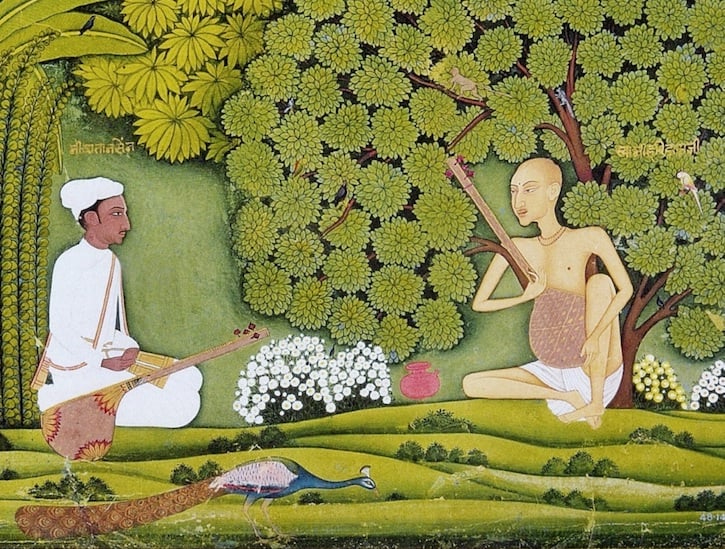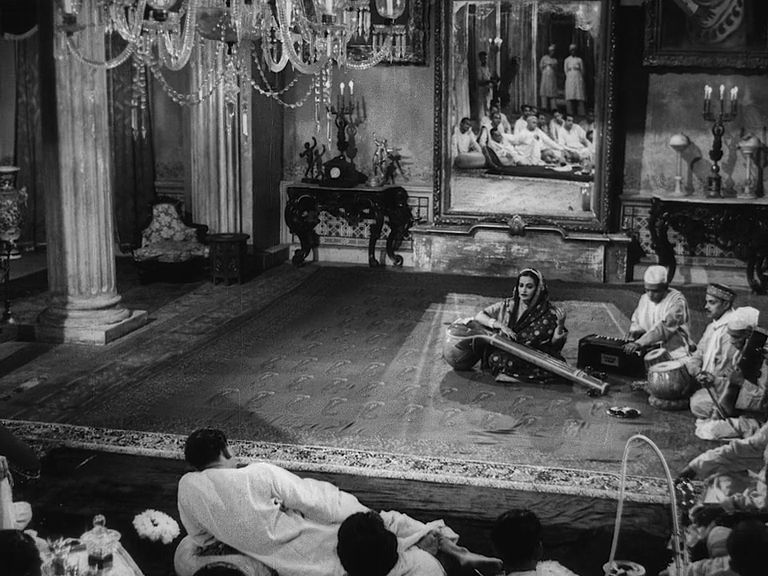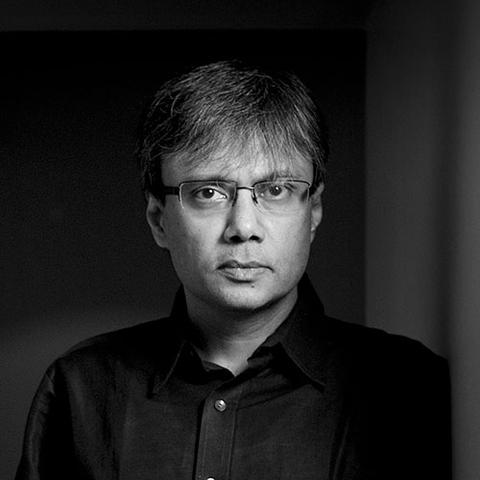The Music Room
On losing and finding Hindustani classical music Detail of a Mughal miniature of Tansen receiving a lesson from Swami Haridas. | Wikimedia Commons.
Detail of a Mughal miniature of Tansen receiving a lesson from Swami Haridas. | Wikimedia Commons. o
r
d
F
a
c
t
o
r
y
Finding The Raga: An Improvisation on Indian Music, by Amit Chaudhuri. New York Review of Books, 272 pages.
Before the pandemic, I traveled for singing lessons to the home of Ustad Salamat Ali, a prominent musician in Pakistan’s—and now, New York’s—Hindustani classical music scene. The trek from my New Jersey apartment to his Queens home took an hour and a half, and I usually showed up a little flushed and out of breath. Ustad ji[1] always cheerfully greeted me at the door with a Salaam.His wife Azra Riaz, who performs alongside him, would bring tea to soothe my throat. I felt fortunate at the chance to be welcomed into their lives. To learn Hindustani music was a dream I’d harbored for much of my life; now that it had come true, at thirty-one, I was almost afraid to hold something so beautiful. As if it were an illusion that might shatter at any moment.
Our lessons have since moved to Skype, but my Ustad and I have worked to preserve their sanctity. To begin with, I open the tanpura[2]on the iTablaPro phone app, which steadily plays the tonic, the upper tonic, and the fifth. I start with the sa, the root note of the key I will sing in, which is usually C-sharp or D. For the warmup, I repeat notes after my Ustad, ascending and descending the octave, rising above and dipping below in glissandos. It’s still a challenge to suppress my instinct for vibrato, a technique I worked hard on while training in the Western classical tradition, but which is frowned upon in Hindustani music. I also have to calm my endless anxiety, which can distort notes. I go on to practice palte for a full half hour. These are exercises with complex sequences of notes, which Ustad ji has me sing at quicker and quicker tempos. It’s his way of instilling in me a deeper understanding of rhythm and pitch, and cultivating my vocal agility and stamina. It can feel tedious at first, but the repetition is meditative and soon gives way to a kind of trance.
My training is in Hindustani classical music, but the genres I learn—thumri and ghazal so far—are considered semiclassical, though loosely raga-based. The word raga, or raag, has several denotations, among which are: color, dye, emotion, passion, love, desire, joy, sorrow, and anger. The ancient musicologist Bharata Muni (who is estimated to have lived between the second century BC and third century CE) divided ragas into eight rasas, or categories, based on the emotion they evoked: romance, comedy, fury, compassion, disgust, horror, heroism, and wonder. In the nineteenth century, musicologist Vishnu Narayan Bhatkhande classified ragas into ten thaator parent scales, according to their notes.
But ragas themselves are more dynamic than scales, and are heavily improvisational, with defining phrases, ornamentations, and varying patterns of ascent and descent. There are prescribed notes to be lingered upon, and others to be avoided—and perhaps even more confusingly for Western listeners—rules that are fixed and others that are flexible. These aspects come together to conjure an aura, a world. The performing musician enters an enduring state of exploration. In the vast expanse of the raga, she is the creator.
As a student of Hindustani classical music, my chancing upon Amit Chaudhuri’s Finding the Raga was a kindness of fate. The book is a hybrid memoir, moving easily between personal anecdote, a performer’s explication of the art form, and social commentary. I read it in dim light, in a sort of trance, listening to singers, ragas, and genres as Chaudhuri introduced them, and a history of Hindustani music unfolded before me. Like the tradition, which values steadiness and a measure of detachment, his prose is calm, measured, and thorough. Chaudhuri pieces together elements of music with a craftsmanship that can only be the result of a lifetime of practice and inquiry.
Though the subtitle promises “An Improvisation on Indian Music,” the book focuses mainly on Hindustani, one among India’s myriad traditions, both classical and folk. Hindustani itself is practiced in other parts of South Asia as well—particularly in Pakistan and Bangladesh. As such, the term “Indian” could be referring to the pre-partition subcontinent, and “Indian music” a simplification for the unfamiliar reader. The word “improvisation” gestures toward the way Chaudhuri theorizes, drawing together meditations on visual art, philosophy, and literature to offer a modern understanding of the ancient art form.

Chaudhuri is well-known to Anglophone readers as a poet, novelist, essayist, and literary critic. Born in 1962 to an upper-caste Hindu family, he grew up in 1970s Bombay, moving in privileged social circles where Hindustani music’s associations with religion and spirituality elicited both reverence and scorn. He writes that everyone around him spoke English and primarily identified with Western culture. As a teenager, Chaudhuri himself idolized Neil Young and Bob Dylan, and even made minor waves as a singer-songwriter. His songs “Shame” and “The Trouble With Being Lonely” could be heard playing on the All India Radio in the early 1980s.
?In Finding the Raga,Chaudhuri revisits the dynamics that governed high society in India, in particular the veneration of Western culture. He asks: To what measure was this connection sincere, and when was it more compulsive and performative? He tends toward the latter explanation, tracing the Indian elite’s disavowal of local traditions back to the interventions of early British colonizers, who took a dim view of Hindustani classical music. (Their other targets included kathakdance and ghazalpoetry, both of which were deemed corrupt and discouraged.)
For his part, Chaudhuri maintains a sharp line between Hindustani and Western classical music, which he argues are birthed from separate ideological and emotional universes. He finds Western music to be comparatively limiting, because of its underlying humanism—which he claims artificially separates us from the natural world. To illustrate the point, Chaudhuri cites the associations of the major scale with happiness and of the minor scale with grief and melancholy. He goes on to discuss the way Beethoven’s Pastoralevokes “images of meadows, trees, weather, and valleys” and later considers the overt mimesis of Flight of the Bumblebee.
In contrast, the raga does not share a merely representational relationship with the world. “There are no scales or sets of notes in North Indian classical music that have a reliable mimetic identity,” Chaudhuri writes. “We [cannot] safely associate them with morning or night, light or dark, joy or sadness.” Instead, he argues that the raga, like language, is a medium with which one can make sense of the world and exist within it. Thus, the “The raga is not about the world; it’s of it.” This is perhaps one reason the British never understood the raga—or cared to.
Chaudhuri credits his own parents for introducing him to Hindustani music. His mother took lessons at home from the late Govind Prasad Jaipurwale—a singer who performed and taught widely at the time. Chaudhuri recounts being struck by the voice of her guru,
He sang softly, without insistence, and almost never sang the same phrase twice. His aim, achieved with modesty, was to surprise and be surprised.
I wanted to do what he was doing. This was odd, as I’d been content till then to sing songs with my guitar. But there was something contagious, arresting, and disruptive of the flow of time about being able to produce, consecutively, two or three versions of a phrase, each with a marginally different emotional impact, each new thought revising the previous one.
I tried to do it when I was alone, and stumbled. Clearly, you couldn’t produce these modulations just because you wanted to.
At sixteen, Chaudhuri began practicing Hindustani classical music with Govindji. For some time, the two disciplines coexisted in him. But at the age of twenty-one—in a turn he calls zealotry—he retreated from his career as a singer-songwriter and began studying Hindustani music intensively and exclusively. In fact, for a decade and a half, he stopped listening to Western music altogether.
?It is a zealotry I know intimately. I grew up having to abandon my mother tongue, Urdu, in order to survive in American society and its school system. Years later, when I understood what had been stolen from me, I tried to gather as many pieces of the language as I could: through books, dictionaries, verses of poetry, and music. It was a rebirth—one art led to another. Soon I was translating Urdu poetry, taking kathak classes, and learning to sing thumris and ghazals. Despite a continuing feeling of untethering, I felt I was rebuilding myself, that somehow, someday, I might feel whole.

Distraction is essential to music, Chaudhuri argues. He speaks of a “weave,” whose origins lie in the Sankritic word maya—often translated as “illusion” or “deception.” For him it is an enchantment—delicate, transient. It is the spell of Krishna’s flute over Radha, whose love for him becomes legendary and sacred. It is the shape of desire, a search for the unknown, a surrender to the divine.
Chaudhuri also uses “the weave” to refer to the singer’s inseparability from her surroundings. In the Hindustani tradition, music is considered one among the many sounds ofthe world, an art which connects us with our primordial selves. The notes of the saptak or octave —sa, re, ga, ma, pa, dha, ni—are all sounds that occur in nature. The note sa, or shadja, is a peacock’s cry; ni, or nishad, the call of the elephant. Being of the world, these notes are effortlessly woven back into its fabric. The Hindustani musician not only “tests notes in relation to each other in a raga, he hears extensions of that relationship in his surroundings.” Upon hearing the bell of the kulfi-wala or ice-cream man, Govindji declares: “It’s hit a fifth!”
Among the joys of Finding the Raga is Chaudhuri’s account of his relationship with Govindji, who imparts to him the kind of wisdom, technical expertise, and appreciation of beauty that one can only learn through oral tradition, by example. He is clearly a virtuosic musician. Yet, as a teacher he is gentle, unassuming, patient, and dedicated, leading Chaudhuri through extended practice sessions, observing his growth as a singer. Govindji’s lessons span the length of the book, forming the core of Chaudhuri’s approach to Hindustani classical music. He writes of his teacher not only with respect, but unmistakable reverence.
There is something untranslatable about the bond that forms between master (guruor ustad) and disciple (shishya or shaagird). The disciple must enter the relationship with humility, in surrender, willing to give in. My relationships with private teachers of Western classical music have been defined by economics and social niceties: short greetings, a sense of focus, an awareness of time’s passage. But for Ustad ji, I am his daughter. I have helped him download apps on his phone, given him health advice; we have marveled over Urdu verses together. There have been times when he has been cross with me for not practicing enough—and this anger, with its demand of diligence, is a right I have given him. Our relationship is less guarded, marked by what in the West might be perceived as lack of professionalism, or a violation of “boundaries.” In its place, there is a form a devotion, a preservation of musical lineage. Ustad ji is himself a shaagirdof the late ghazal singer Mehdi Hassan, and he is full of stories about the late maestro. When I listen closely, I hear something of Hassan alive in him.
Chaudhuri isengaged in an act of translation, however. At times, he is translating his traditions to an audience that may not have encountered Hindustani music. He is also translating one part of himself to the other—as must all of us who carry multiple inheritances. I recognize in both of us a push-and-pull, a kash ma-kash—an internal battle of ideologies which both demand prominence. Chaudhuri quotes a passage from the Bengali writer and intellectual Rabindranath Tagore, who speaks to the severity of this perceived dichotomy:
If you wake up and sit like this in the middle of the night, in the midst of such a scene, you feel as if you and the world are somehow in some way made anew, as if the world of daylight and commerce with men had become utterly untrue. Again, waking up this morning, how far away and indistinct that world of my night has become. For man, both are true, yet both are terribly independent of each other . . . Ours is the song of personal solitude, Europe’s is that of social accompaniment. Our music takes the listener outside of the limits of man’s everyday vicissitudes to that lonely land of renunciation that is the root of the entire universe, while Europe’s music dances variously to the endless rise and fall of man’s joys and sorrows.
??????????????????????????????????????????????????????????????????????? ??????????? (trans. Rosinka Chaudhuri)
But are Hindustani and Western classical music indeed night and day? Having studied them both with all my heart, I understand the instinct to separate them wholly. In my devotion for one or the other, a veil is cast upon my consciousness which occludes view of the other. But both arts come from the same dark, indefinable space within me—a place beyond the self. Here, slowly, beauty and truth begin to descend as revelation upon the mind. In all singing, as in meditation, we are aware of our breathing in such a way that we cannot help but remember we are alive. And in the insistence of breath, we must also acknowledge the life around us. We are tied, in the truest experience of music, to our own selves, to one another, and to the world.
In truth, Chaudhuri does not entirely separate the ragafrom all Western musical traditions. His main grievance seems to be with Western music’s hegemony, its dominance over other traditions. As we near the end of the book, he briefly discusses some of the contemporary Western music he admires. He praises John Lennon for his calmness and detachment, for “choos[ing] to barely exist” in his songs. He admires Louis Armstrong and Ella Fitzgerald’s “eschewal of vibrato.” He also loves the blues, a genre in which note takes precedence over the singer. Here, Chaudhuri begins to blur the sharp distinctions between Western and Hindustani music that he seemed to uphold before.
At a performance at the 2010 Jaipur Literary Festival, Chaudhuri sang, accompanied by two? guitarists, a keyboardist, and a tabla player. Later, he told the audience of a moment during his morning riyaaz(practise), when he heard a sequence of notes from the raga Todithat recalled the refrain of Eric Clapton’s “Layla.” At the same time, Chaudhuri’s named his concert, “This is Not Fusion.” What I hear in the name is an intent to render not a conscious endeavor of convergence, but rather something that occurs naturally, all on its own.
A particularly striking poem of his titled “The Writers” follows one such “mishearing”—to quote the title of the book’s last section—to its end. As the preface states, it is a poem “on constantly mishearing ‘rioting’ as ‘writing’ on the BBC.” The result is both humorous and startling:
There has been writing for ten days now
unabated . . .The writers have been burning cars; they’ve thrown
homemade Molotov cocktails at policemen . . .Long-standing neglect
and an absence of both authority and employment
have led to what are now ten nights of writing.
Thus we learn that semblance, even if by accident, can reveal truth. But we must ease ourselves, quiet the mind’s noise to hear it. In Finding the Raga, Chaudhuri teaches us that human expression can be refined in a way that pretense falls away, and we lose ourselves in the weave of existence, through which we hear the world in ourselves and in each other. We come to know the self and transcend the self.
[1] Ustad means “teacher” in Urdu and Hindi. “Ji” is a marker of respect, like “Don” in Spanish.?
[2] The tanpurais a long-necked string instrument. But the word also refers to the harmonic bourdon produced by plucking its strings. This serves as a rhythm or background that sustains the singer’s melody.